- Creaig Dunton
- Albums and Singles
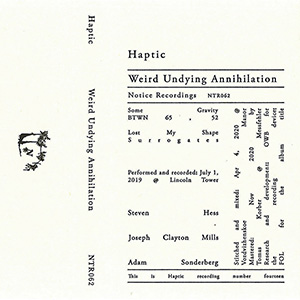 Recordings of sound art installations are always a bit troublesome, since it is an attempt to distill a spatial experience into a (usually) two channel stereo recording, meaning something is lost in translation. The latest work from the trio of Steven Hess, Joseph Clayton Mills, and Adam Sonderberg combines the intent and structure of an installation, but in the form of a live performance where each performer performed within their own specific space, and specifically intended for an external listening experience. While that may sound convoluted, it results in a tape that features an amazing sense of space and movement, even if it is just a recording.
Recordings of sound art installations are always a bit troublesome, since it is an attempt to distill a spatial experience into a (usually) two channel stereo recording, meaning something is lost in translation. The latest work from the trio of Steven Hess, Joseph Clayton Mills, and Adam Sonderberg combines the intent and structure of an installation, but in the form of a live performance where each performer performed within their own specific space, and specifically intended for an external listening experience. While that may sound convoluted, it results in a tape that features an amazing sense of space and movement, even if it is just a recording.
The spatial element of this material is undeniable from the opening moments of "Some Gravity." The trio cover subtle electronic tones with churning static and deep blasts of three-dimensional sound. It is extremely active, complex, and challenging without being harsh or oppressive. The use of droning tonal elements on "BTWN 65, 52" beautifully contrasts the reversed stutters and fragments that are all covered by what sounds like the deep rumble of a passing train.
The trio leans heavier into rhythmic elements on the other side of the cassette, albeit in the most abstracted form possible. "Lost My Shape" is a multilayered noise experience that is distinctly anchored by clicks, thumps, and dull thuds that certainly sound percussive in nature, but hardly resemble anything close to a drum. The final piece, "Surrogates" has the ambience of being within a large idling machine, complete with external banging and clattering, but a subtle piano motif stays prominent throughout, providing an excellent contrast.
Pandemic recordings are a concept that is already becoming cliché, but Haptic (intentionally or not) have created a perfect one with Weird Undying Annihilation. By so deftly capturing the experience of both live recordings and dynamic sound installations into a format that can be fully appreciated in complete isolation. It is an excellent substitute while standing completely on its own strengths, and never just seeming like a "best approximation" of the live, spatial context. The depth and complexity of these recordings is astounding, and the trio do an unbelievable job of capturing both place and motion in only two channels of sound.
Samples can be found here.
Read More
- Anthony D'Amico
- Sound Bytes
 Saltern's latest Yoshi Wada reissue unhappily coincides with the composer's unexpected passing, but at least he managed to live long enough to see his work get some wider appreciation in recent years. Or at least managed to see some of his major albums finally get remastered and released outside Japan, as "wider appreciation" is very relative when one's vision is as unapologetically challenging as Wada's. In fact, I always viewed him as a Final Boss in the appreciation of difficult and adventurous music, as it takes a lot of immersion in dissonant and outré sounds before one reaches the "I crave a deep dive into avant-garde bagpipes" stage. In fact, I am not sure I am yet there myself. Given that, The Appointed Cloud is probably more for devout connoisseurs of sound art's more prickly fringes than, say, the heavy drone of Wada's 2009 triple LP Earth Horns With Electronic Drone. However, this album was one of Wada's personal favorites, as it documents the "memorable" opening performance of his "first large-scale, interactive installation" at the Great Hall of the New York Hall of Science in 1987 (which featured "spaceships hanging from the ceiling so people felt like they were traveling in outer space"). That certainly seems like a suitably disorienting environment for sounds this fascinating and unique. I dearly wish someone had thought to film some post-concert audience reactions, as I bet they were quite something.
Saltern's latest Yoshi Wada reissue unhappily coincides with the composer's unexpected passing, but at least he managed to live long enough to see his work get some wider appreciation in recent years. Or at least managed to see some of his major albums finally get remastered and released outside Japan, as "wider appreciation" is very relative when one's vision is as unapologetically challenging as Wada's. In fact, I always viewed him as a Final Boss in the appreciation of difficult and adventurous music, as it takes a lot of immersion in dissonant and outré sounds before one reaches the "I crave a deep dive into avant-garde bagpipes" stage. In fact, I am not sure I am yet there myself. Given that, The Appointed Cloud is probably more for devout connoisseurs of sound art's more prickly fringes than, say, the heavy drone of Wada's 2009 triple LP Earth Horns With Electronic Drone. However, this album was one of Wada's personal favorites, as it documents the "memorable" opening performance of his "first large-scale, interactive installation" at the Great Hall of the New York Hall of Science in 1987 (which featured "spaceships hanging from the ceiling so people felt like they were traveling in outer space"). That certainly seems like a suitably disorienting environment for sounds this fascinating and unique. I dearly wish someone had thought to film some post-concert audience reactions, as I bet they were quite something.
Saltern/EM Records/Edition Omega Point
There are some artists who seem like that they have absolutely no influences other than themselves, but there are also some equally rare visionaries who combine such bizarre and seemingly clashing influences that they seem equally unique. Yoshi Wada was arguably the king of the latter camp, as he began his creative life studying sculpture in Kyoto before moving to New York in the '60s and falling in with the burgeoning Fluxus scene there. He also studied composition with La Monte Young, North Indian classical singing with Pandit Pran Nath, and Scottish bagpipes. That impressive collision of jarringly divergent impulses makes sense if one simply accepts that Wada was a deeply curious person though. And The Appointed Cloud similarly makes sense if one understands that sculpture was Wada's first love and that Fluxus showed him a path to applying those talents to music, as one of its primary themes is emphasizing the artistic process over the finished product. Appropriately, process lies at the heart of this performance, as it is a based around "a custom pipe organ, among other homemade instruments, controlled by a computer equipped with a customized interface and software designed by engineer David Rayna." The ensemble is further rounded out by four bagpipe players (one of whom was Wada) and a percussionist. All of those elements make their presence strongly felt at various points, but most of the album sounds like a very tight and professional bagpipe ensemble with one rogue member who keeps steering them towards crescendos of squalling dissonance (and it also sounds like he may have invited some friends from a gagaku ensemble along). It also occasionally sounds like a pipe organ jam at a Zen retreat, an air raid drill during a mass at a cathedral, a flock of crazed geese fleeing a storm, or an appealingly frayed and out-of-phase Philip Glass homage. Needless to say, that makes for quite a wild and unpredictable ride and it is not one for the timid: Yoshi Wada was truly a one-of-a-kind artist and The Appointed Cloud is exactly the sort of ambitiously challenging and strikingly unfamilar album to (emphatically) affirm that.
Samples can be found here.
- Anthony D'Amico
- Albums and Singles
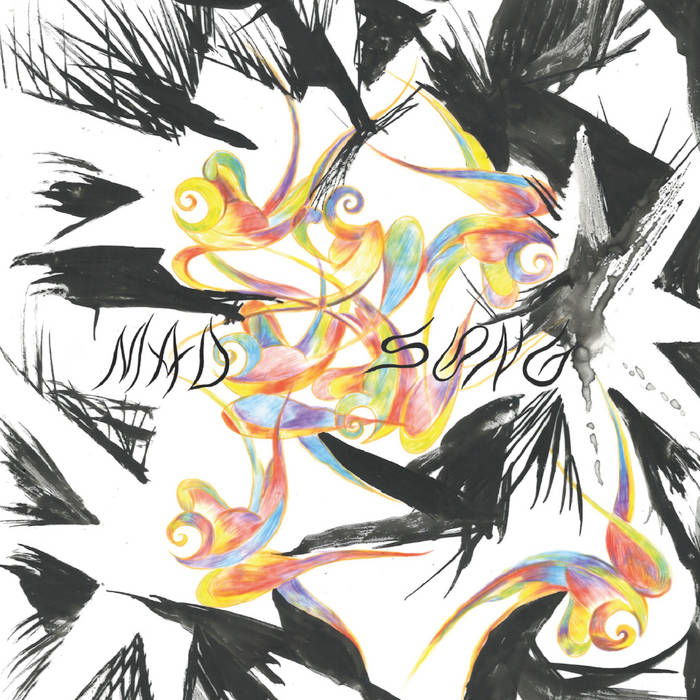 People often grumble about how music used to be better and that usually just means that they are either looking in the wrong places or not paying close enough attention, but every now and then I get blindsided by something from decades past that makes me concede that there is indeed some truth to that stance. I mention that because Louise Landes Levi is one of the few remaining artists from the late '60s Mills College/NYC avant-garde golden age who is both active and seemingly still in her creative prime. Admittedly, her discography was quite sparse until the last decade or so (much like that of Catherine Christer Hennix), but the woefully delayed appreciation of Levi's work feels like it was less due to sexism and a challenging vision than because documenting her art seems like trying to capture lightning in a bottle. Fortunately, Sloow Tapes' Bart De Paepe was up for the challenge and Bombay Lunatic Asylum is a recently formed trio that brings out some of Levi's best work. In practical terms, that mostly means that De Paepe and Koen Vandenhoudt just hung back, made some drones, and (presumably) watched in awe as Levi unleashed an passionate and fiery sarangi tour de force that calls to mind a Zen Paginini. This album is amazing.
People often grumble about how music used to be better and that usually just means that they are either looking in the wrong places or not paying close enough attention, but every now and then I get blindsided by something from decades past that makes me concede that there is indeed some truth to that stance. I mention that because Louise Landes Levi is one of the few remaining artists from the late '60s Mills College/NYC avant-garde golden age who is both active and seemingly still in her creative prime. Admittedly, her discography was quite sparse until the last decade or so (much like that of Catherine Christer Hennix), but the woefully delayed appreciation of Levi's work feels like it was less due to sexism and a challenging vision than because documenting her art seems like trying to capture lightning in a bottle. Fortunately, Sloow Tapes' Bart De Paepe was up for the challenge and Bombay Lunatic Asylum is a recently formed trio that brings out some of Levi's best work. In practical terms, that mostly means that De Paepe and Koen Vandenhoudt just hung back, made some drones, and (presumably) watched in awe as Levi unleashed an passionate and fiery sarangi tour de force that calls to mind a Zen Paginini. This album is amazing.
There are technically three songs on Mad Song, but it is very easy forget that anything exists other than the haunting and incendiary opener "The Mental Traveller." Over a backdrop of harmonium drones, Levi unleashes a raw, viscerally cutting, and almost possessed-sounding sarangi showcase that calls to mind a pagan ritual in which a sensuous dance reaches such a fevered intensity that the dancer drops dead afterward. It is incredibly powerful and moving, yet also impressively hallucinatory. In fact, the macabre ballet feels both feral and almost supernatural, as the many animal-like sounds Levi coaxes from her sarangi sometimes feel like an anguished flock of birds dispersing in fear because the dancing, howling melodies are simply too primal and darkly erotic to handle. It also sounds like Levi has a magic homemade effects pedal that makes everything sounds unnaturally and vividly tactile and earthy (quite a neat trick). I believe Vandenhoudt also plays sarangi on that opening piece, as there are some overlapping melodies and drones, but he switches to the shruti box for the more mournful and meditative "Ancient Times." Unsurprisingly, it is yet another gem, but Levi's playing is considerably more lyrically melodic and the drones play much more of a central role, imbuing the piece with a densely buzzing and lazily oscillating seismic heft (they almost sound electronic, in fact). Despite the slight dip in intensity, "Ancient Times" is nonetheless impassioned and unconventional in its own right, as Levi unleashes some mind-burrowing harmonic squeals and the trio's drones seem to conjure the otherworldly harmonies of Just Intonation (though that may just be an illusion). The album ends with a brief vocal coda/comedown in which Levi sings William Blake’s "Mad Song" over another harmonium backdrop, approximating something akin to a lovely but simple Kink Gong piece or great Sublime Frequencies find. It all amounts to a truly wonderful and singular album, as listening to Mad Song feels like an almost ecstatically religious experience.
Samples can be found here.
Read More
- Eve McGivern
- Albums and Singles
 Best friends Valerie Green and Paige Shedletsky have collaborated across the heartland of the United States in various projects since 2009, the latest as Karate, Guns & Tanning. With the start of the COVID-19 pandemic in 2020, the duo took the time to complete their debut album Concrete Beach. The band name, taken from a strip mall sign, serves as a hint of the variety of musical content within, ranging from teenage garage-tinged pop to fuzz-driven rock with '90s sensibilities. Green and Shedletsky, as musicians with self-professed eclectic musical tastes, make waves large and small for nearly any kind of sound surfer.
Best friends Valerie Green and Paige Shedletsky have collaborated across the heartland of the United States in various projects since 2009, the latest as Karate, Guns & Tanning. With the start of the COVID-19 pandemic in 2020, the duo took the time to complete their debut album Concrete Beach. The band name, taken from a strip mall sign, serves as a hint of the variety of musical content within, ranging from teenage garage-tinged pop to fuzz-driven rock with '90s sensibilities. Green and Shedletsky, as musicians with self-professed eclectic musical tastes, make waves large and small for nearly any kind of sound surfer.
I'm a sucker for categorization, and this one took me a couple of listens through before I realized that Concrete Beach refuses this. Karate, Guns & Tanning consists of Shedletsky (keyboards) and Green (bass and lead vocals), with mean guitar work from Joy Caroline Mills and tight drumming from Daniel Guajardo. The musicians explore a wide gamut of music styles, so it's easy to move on from one song when the mood doesn't suit. My first exposure to the album was through the video for "Artifacts," filled with wailing guitars and haunting keyboards as fuzzed-out vocals exclaim, "We’re gonna fly high / we’re gonna get out, get out of here." Karate, Guns & Tanning have indicated that much of the album was an expression of frustration in lockdown, and like other albums from 2020, I expected the rest of the album might follow suit. Yet "Clockwork" oozes exuberance, sprinkled with disco and topped off with twee, making this song an undeniably catchy earworm suitable for the dance floor. I found further comfort in the ethereal, heart-rendering "Zenith," full of angelic vocals, guitar jangle, and plenty of dreamy fuzz. The album is wonderfully balanced, riding out on an apocalyptic SciFi vision of robots overtaking humanity with "Hot Bots," a punk girl garage slab of fuzz that tickled my old Riot Grrl sensibilities. "Fight kick bite scream, heart beats living machine, tell them we’re losing steam." Hell yes! It took a few tries to catch a wave, but the variety of surf allowed me to get into the line-up and crest.
Sound samples can be found here.
The video for "Artifacts" can be found here.
The video for "Hot Bots" can be found here.
The video for "Clockwork" can be found here.
Read More
- Duncan Edwards
- Albums and Singles
 This set all too briefly demonstrates why, from Henry Cowell to Tim Hecker, via La Monte Young, Alan Hovhaness, Olivier Messiaen, Lou Harrison, Benjamin Britten, and Ákos Nagy, many Western composers have been inspired by the sacred other-wordly elegance of gagaku music. Based on the tracks by Suenaga Togi and gagaku musicians from the Imperial Household Orchestra, a whole album by them is high on my list of coveted items. There are a variety of other styles here, with dazzling twangy sounds from the three-string samisen, Zen-meditative bamboo flute, a xylophone made of stones, boisterous songs from puppet theater, and enough surface noise to satisfy any connoisseur of hiss and crackle.
This set all too briefly demonstrates why, from Henry Cowell to Tim Hecker, via La Monte Young, Alan Hovhaness, Olivier Messiaen, Lou Harrison, Benjamin Britten, and Ákos Nagy, many Western composers have been inspired by the sacred other-wordly elegance of gagaku music. Based on the tracks by Suenaga Togi and gagaku musicians from the Imperial Household Orchestra, a whole album by them is high on my list of coveted items. There are a variety of other styles here, with dazzling twangy sounds from the three-string samisen, Zen-meditative bamboo flute, a xylophone made of stones, boisterous songs from puppet theater, and enough surface noise to satisfy any connoisseur of hiss and crackle.
Anyone familiar with Victrola Favorites will have an inkling of what to expect from this set of ultra-rare early 20th century recordings from Japan, collected by Robert Mills: 78 rpm-related exotica in the form of intriguing photographs, a variety of sounds, with good information concerning the instruments, plus cultural and historical context. Sound Storing Machines is nowhere near as lavishly packaged as Victrola Favorites (few releases are) but it comes with enough generous and intriguing information to distract from the listening process. This is not a criticism, but I decided to approach it with several full listens without reading any background, without concern for like or dislike, and merely with openness, and the spirit of “disinterestedness.” John Cage has suggested that for the making of music to have the possibility for complete and fulfilled moments one should make music “as the Orient would say” for the love of making it, as opposed to the pursuit of fame or wealth. Listeners and musicians alike should approach music disinterestedly, in order to integrate the personality - which is "why we love the art." Without much thought I first listened at low volume on tiny inbuilt laptop speakers. I began to think that this music is the perfect pitch for earbuds,which I don't possess, and only later I tried using good quality headphones at even lower volume. I will never play this album loudly through speakers.
 
Most of the recordings were done by Fred Gaisberg of the Gramophone Company and he apparently had mixed feelings:
"28 February, 1903, Tokyo: We made records of the Imperial Household Band. The orchestra was composed of 12 men and their music was weird & fascinating indeed. Though they played some 10 pieces it was impossible to distinguish one tune from another."
As aforementioned, I want a complete album by the Imperial Household Band, based on their tracks "Bairo" and "Taishikichou," which I found to be stunning flashes of a deeply beautiful ancient ceremonial music. A different style but almost as dazzling is "Senryou Nobori" which features an unknown vocalist accompanied quite brilliantly by Toyosawa Heikichi on a three stringed banjo-like instrument (samisen). This is played in the demanding Gidayu style, developed for use with puppet theater. Since Senryou Nobori was a sumo wrestler it is easy to imagine the puppet action. Later in the album, more melodramatic songs about men and families destroyed by deceit, by over-devotion to monkeys and so on seem a little preposterous, but provide contrast and have aged well for being more than a century old. The recording technology available to Gaisberg meant that the musicians had only short time to complete their work. So short that I find it hard to believe the song "Sanjusangen-do Kiyori" could possibly explore the architecture of the Sanjusangen-do Buddhist temple (from 1164 AD) featuring a hall with 1001 almost life-size statues of the Japanese bodhisattva of compassion.
There is "Collecting Water" featuring Mimasuya Kachiguri, with an unknown samisen player, on the sekkin - a kind of a xylophone made of stones used to imitate the sound of water. And there is also the shakuhachi - a bamboo flute associated with the blowing meditation of Fuke Zen monks known as "priests of nothingness." In medieval times, the ruling Shogun granted the monks an exemption to travel bans due to their wandering spiritual practice, along exclusive rights to play the instrument. This in exchange for some of them spying for the shogunate. Shogun spies also easily infiltrated the Fuke, who wore wicker baskets over their heads to symbolize their retreat from the world. In response extremely difficult shakuhachi tunes were developed as a way to root out, and sometimes kill, impostors.
The performers here probably had no idea what would happen to their recorded sounds. Some (if not all) of them would surely never have heard the result. It would be several decades until the invention of the small portable Presso Shellac Lathe and microphone used by John and Alan Lomax in many of their field recordings. Lomax could almost immediately play the recording back to the artist. Fred Gaisberg, on the other hand, would record without electricity into a large horn device, transfer to master wax cylinder, and ship these to Europe for duplicate pressings which would then have to be imported back to Japan and distributed elsewhere. He was only able to do so since the reign of the Meiji emperor 1868-1912 started Japan’s move to national modernization and openness to mechanization and globalism.
Just as ripples move concentrically outward from a stone dropped into a pool, sound travels far beyond its original point of creation. Several of these pieces are early 20th Century versions of tunes which are several hundreds of years old. And of course, in the late 1960s, the shakuhachi recording by Gorō Yamaguchi A Bell Ringing in the Empty Sky featured a piece NASA would later chose as part of the Golden Record placed aboard the Voyager spacecraft. From wicker baskets to space helmets.
 
Read More
- Anthony D'Amico
- Albums and Singles

Much like Vox Populi!'s Half Dead Ganja Music, Leven Signs' Hemp is Here first began life as an obscure and deeply weird cassette from the '80s, but eventually found its way to someone who appreciated its warped and singular vision enough to give it a well-deserved second life. In the case of Leven Signs, that someone was Foxy Digitalis's Brad Rose, who reissued the album back in 2013. At the time, I felt it was more indulgent, rough, and self-consciously bizarre than legitimately good, but now that it has been reissued once again, I realize that I was an absolute fool for sleeping on it before and that I was simply not yet attuned to Leven Sign's "fourth world post-punk" wavelength. Admittedly, a few songs still feel a bit maniacal to me, but the album's high points truly feel like some of the most inspired, boundary-dissolving, and near-ecstatic music that I have ever heard. I feel like there should probably be a statue of Pete Karkut somewhere, as he was arguably one of the most wonderful DIY visionaries to ever walk the earth, surfacing for just one absolutely mindblowing tape, then riding off into the sunset (leaving the rest of us to spend the next three decades slowly evolving until we could properly appreciate what he had done).
Futura Resistenza/Digitalis/Cordelia
I believe it was the opening "Our Position Vanishes" that threw me back in 2013, as it sounds like a sped-up loop of 'ethnic music' accompanied by a howling teakettle, a primitive synth bass line, and male vocals that seem to emanate from the bottom of a well. It calls to mind whirling Sufi dervishes, but hypercaffeinated and in lysergic, Day-Glo color. Eight years later, it is still not quite for me, but it is followed by the first of several masterpieces to come, as "Prague Spring" marries a catchy flute hook, chant-like female vocals, and a killer percussion groove that calls to mind a hot dub single recorded by a tropical party band (and one that briefly dissolves into a full-on symphonic mindfuck, no less). The next stunner is "Sedes sapientiae," which sounds a lovely ancient folk song sung over a delirious jam session between a church organist, a funk drummer, and an unusually intense choir of Gregorian monks (and somehow it manages to sound both majestic and vaguely industrial as well). The next flurry of greatness does not come til the end of the album, but the final three pieces are pure outsider-psych nirvana. In "Rumi," Karkut and Maggie Turner conjure up something akin to a ghostly Sybille Baier demo tape and a Middle Eastern-inspired organ jam colliding over a PVC pipe percussion groove, while "Das Seal" sounds like someone threatened to murder a church organist's entire family if he did not nail his audition for a space rock band. The closing "Held in Arms," on the other hand, initially sounds almost "pop," as Turner quietly sings a wistful melody over a great clattering, dubby groove. As it unfolds, however, it starts to feel like a snake charmer just joined the jam and that Karkut went on a wild shopping spree at The Psychedelia Store and cleared the damn shelves. The rest of the album is a fascinating mix of inspired near-misses ("La Luna" sounds like a tipsy Scott Walker crashing a PIL tribute band rehearsal) and second-tier pleasures, but the whole damn thing is a memorably unique and infectiously groove-driven feast of unfettered originality and go-for-broke adventurousness.
Samples can be found here.
Read More
- Anthony D'Amico
- Albums and Singles

This latest release from Montreal-based composer/collaboration enthusiast Jeremy Young is quite an intriguing and adventurously kaleidoscopic suite of songs, as his revolving door of guest artists brought together quite an eclectic array of divergent aesthetics. While most of Amaro's participants were previously unfamiliar to me, all feel like unerringly solid choices, as these ten pieces feel like a single coherent vision that spread its tendrils outward into pleasantly unexpected terrain that beautifully blurs quite a few lines. While Amaro is arguably an ambient/drone album at its heart (Young's main tools are oscillators, tape loops, amplified surfaces, and EMF signals), it often feels like something considerably more compositionally and conceptually ambitious is happening, as there are nods to influences as diverse as Conlon Noncarrow, The Caretaker, and Scanner (as well as some thoughtful inspirations beyond music). As such, Amaro initially drew me in as an unusually good drone album, but it sneakily blindsided me several times once I gave it focused attention and sufficient volume.
The opening "Trafic" is a prime example of Young's inventively boundary-dissolving aesthetic as he is joined by filmmaker Tomonari Nishikawa (who "plays" a 16mm camera & a projector). Naturally, the expected projector sounds are present, yet they are just a small part of a concoction that sounds like a spectral haze of feedback jamming with some garden sheers, a jazz bassist, and a ping-pong game remixed by Pole. The following two pieces are also gems, as "Ballroom Loop #1" sounds like an excerpt from a killer lost William Basinski album, while "Frequenza Bianca" enlists Dolphin Midwife for a lovely harp improvisation that sounds like it takes place inside a shimmering dream mist of quivering droplets frozen in time. Elsewhere, "Electricity Over Mirabel" is another favorite, as violinist Pauline Kim Harris taps in for a gorgeously haunting string motif that is dissonantly smeared, stretched, and atomized. It too coheres into a crackling and popping Pole-style rhythm, but the nightmare happening over it is a malevolently hallucinatory delight. Nearly every single piece on Amaro hits the mark, however, so it was a real pleasure to hear the fascinating places that Young was able to steer his collaborative curveballs. For example, "Mythy" sounds like Alvin Lucier remixed Algebra Suicide's "True Romance at the Worlds Fair," while "The Duchamp Bicycle Wheel Resonator" turns an interview with Vito Ricci into a shifting fantasia of chiming and skittering metal percussion. On the more musical side, "Your Air Smells Like Cinnamon" sounds like an frenzied, out-of-control player piano being soothed with warm drones, while “Carta Vetrata” transforms garbled police radio transmissions into such an achingly beautiful piece that I actually started feeling like the radio was lovesick. That is arguably Young's finest act of sorcery, but it gets strong competition from the closing "Tiny Pine Cones," as Ida Toninato's wordless vocals and crackling pine cones build to a crescendo akin to simultaneously experiencing a haunted house and Disney's "It's A Small World" ride at supernaturally slow and fast speeds. Obviously, I prefer some pieces to others, but it is extremely hard to imagine anyone interested in sound art making it all the through Amaro without being dazzled by at least two songs.
Samples can be found here.
Read More
- Anthony D'Amico
- Albums and Singles
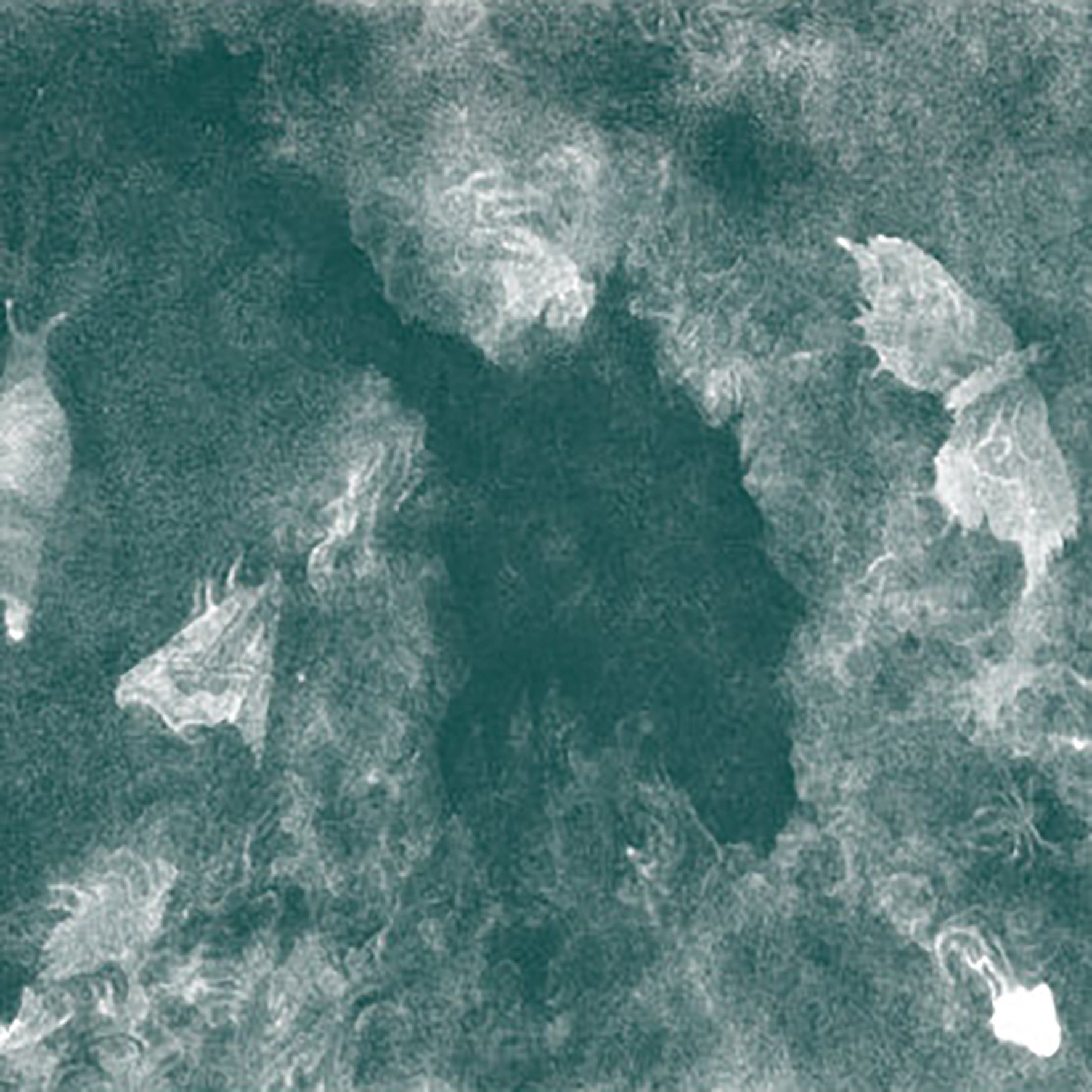
I was certainly not expecting a follow up to March's Éclipse des Ocelles to arrive this quickly, yet here we are with Paroles Cavernicoles ("cave lyrics"), which is a very different animal than its predecessor. While this latest release promises still more "dazzling drone-folk hymns," it also promises "ghostly ambient passages," which is definitely the bit where the two albums significantly diverge. While both releases are quite good, it seems fair to say that Éclipse des Ocelles was Métayer's "songs" album and Paroles Cavernicoles is her "fall down a rabbit hole of shapeshifting rustic psychedelia" album. That is admittedly one of my favorite genres, so I am delighted to join Métayer in her journey through the looking glass, but this album almost feels like the work of a completely different artist altogether (like the cool violinist who made Éclipse des Ocelles has a more effortlessly outré twin who considers herself a non-musician, but will occasionally pick up an instrument to add some weird sounds to her hallucinatory vocal collages).
The album is divided into two longform pieces, "Partie I: Troglophonie" and "Partie II: Grottes Graciles." The first piece initially sounds like a very good Finnish psych-folk album from Fonal, as a tender and lovely vocal melody unfolds over a cool rhythmic choral backdrop. After a couple minutes, however, Métayer dials up the intensity significantly with an interlude of moaning, tortured violin before the bottom drops out entirely and I suddenly find myself lost in a darkly lysergic enchanted forest. Quite a disorienting cavalcade of surprises then ensues, as "Troglophonie" dizzyingly passes through phases that alternately resemble an attempt to summon Pan with an eerie flute melody, a distant thunderstorm played through a chain of effects pedals, a seductive android transmitting a warning from the future, a large wind chime made from old milk bottles, a chorus of ghostly owls, and an avant-garde string ensemble performing while the yawning mouth of hell slowly opens nearby. In a broad sense, "Grottes Graciles" is a continuation of that same trippy free-form free fall right down to its similarly lovely opening (a loop of hazy, swooning vocals gives way to passage of warm drones and a lovely, bittersweet violin melody). In fact, it almost feels like a phantom folk ensemble is teasingly and erratically materializing and dematerializing, but they ultimately fade away to leave me in a haunted cathedral just in time for choir practice. Unfortunately, there was just an avalanche at the experimental music festival further up the mountain, so everything is soon engulfed in a cacophony of jumbled weirdness. Naturally, it all ends with something resembling a brief yet spirited infernal hootenanny (wipes sweat from brow). Needless to say, Paroles Cavernicoles is quite a vividly realized and otherworldly experience, leaving me with the feeling that a supernatural puppet show just swept through my medieval village and nothing and no one can ever be the same again.
Samples can be found here.
Read More
- Anthony D'Amico
- Albums and Singles
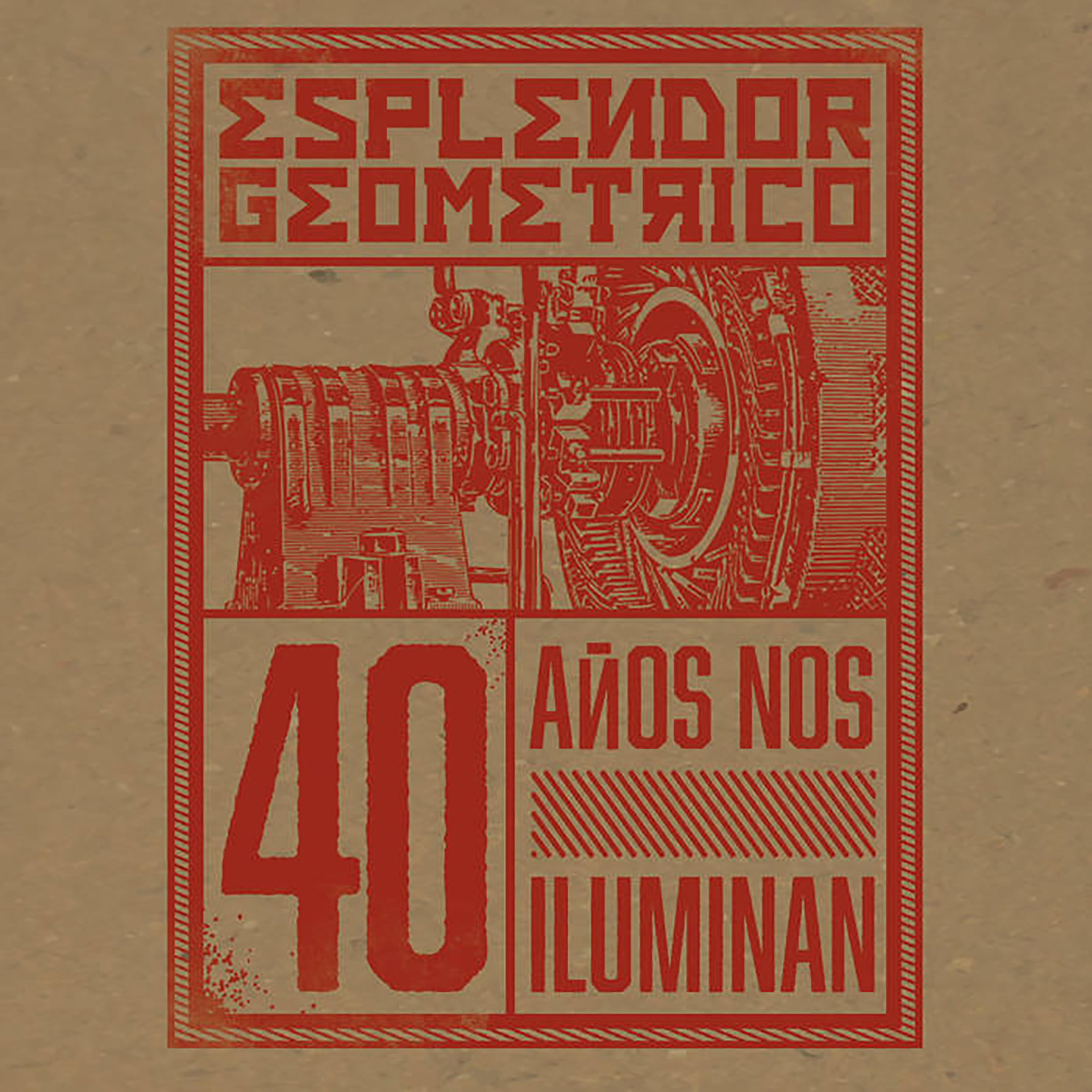 This is definitely one of the more confounding Esplendor Geométrico releases in recent memory, as it is ostensibly a celebration of the project's 40th anniversary (the title translates as "40 years illuminate us"), but is also ostensibly all-new material that somehow feels like at least three different bands. There is a logical explanation for that, as the album features several collaborations, some recent compositions, and a number of noisy, pummeling throwbacks to EG's early years (presumably revisiting that style with the benefit of four decades of illumination). An impressively honest additional explanation can be found in the liner notes, however, as the duo note that neither member makes a living from music, which frees them to "do what they want without even thinking of what their fans and followers expect." As a longtime EG fan, I can confirm that this album was definitely made without any consideration for whether or not I would like it (or whether it even makes complete sense). Then again, anyone who has been releasing great albums for several decades is entitled to celebrate with a go-for-broke, everything-but-the-kitchen-sink epic if they feel like it. It is all perfectly fine by me, but anyone simply searching for a good recent EG album should give this one a wide berth and head towards Cinética instead (also from 2020). That said, there are definitely plenty of bludgeoning percussion assaults here that fans of the project's noisier side will enjoy (as long as they do not mind sifting through an unusually prickly, blunt, eclectic, and overwhelming batch of songs).
This is definitely one of the more confounding Esplendor Geométrico releases in recent memory, as it is ostensibly a celebration of the project's 40th anniversary (the title translates as "40 years illuminate us"), but is also ostensibly all-new material that somehow feels like at least three different bands. There is a logical explanation for that, as the album features several collaborations, some recent compositions, and a number of noisy, pummeling throwbacks to EG's early years (presumably revisiting that style with the benefit of four decades of illumination). An impressively honest additional explanation can be found in the liner notes, however, as the duo note that neither member makes a living from music, which frees them to "do what they want without even thinking of what their fans and followers expect." As a longtime EG fan, I can confirm that this album was definitely made without any consideration for whether or not I would like it (or whether it even makes complete sense). Then again, anyone who has been releasing great albums for several decades is entitled to celebrate with a go-for-broke, everything-but-the-kitchen-sink epic if they feel like it. It is all perfectly fine by me, but anyone simply searching for a good recent EG album should give this one a wide berth and head towards Cinética instead (also from 2020). That said, there are definitely plenty of bludgeoning percussion assaults here that fans of the project's noisier side will enjoy (as long as they do not mind sifting through an unusually prickly, blunt, eclectic, and overwhelming batch of songs).
For better or worse, Arturo Lanz and Saverio Evangelista definitely did not exert themselves coming up with anything beyond just beats and textures for this album. Given EG's considerable prowess in those regards, however, that is hardly a deal-breaker and may even be considered an "all killer, no filler" back-to-basics treat (depending on one's perspective and appreciation for well-executed brutality). In theory, all the best pieces should be on the first disc since the second one is composed of pieces omitted from the vinyl. In reality, however, there are gems scattered fairly liberally across both halves. On the main album, there are a few enjoyable collaborations and a number of EG's standard bulldozing rhythmic juggernauts, but there are some real surprises too. The biggest one is probably the psychotropic sound collage "Buenos Días," which sounds like loops of machine noise jamming with ducks, bullfrogs, and a language tape, but my notes for other songs are filled with phrases like "a herd of cows and a bad metal guitarist just crashed band practice," "Muslimgauze with the intensity dialed up too high," "wrong-speed party anthem," or "a churning, unstoppable industrial groove just rolled through a playground and crashed into an arcade." That last piece ("Vuelve A Jugar") is one of the album’s best, though I also enjoyed "MokBa" quite a bit (massive primitive robots transform a political march into a delightfully lurching dance party). Weirdly, the second disk probably has the better hit-to-miss ratio and the wildest twists. For example, "Avanti" sounds like NWW went completely feral while recording "Rock’n’Roll Station," while "Hungry" resembles a power electronics guy and a black metal band collaborating on an absolutely scorching drone album. Elsewhere, "Trans" evokes a heaving half-gelatinous/half-mechanized horror, while "Tribuna Del Trabajo" sounds like an weirdly sensual and industrial-damaged festival parade shimmying its way through a vintage arcade. Admittedly, trying to listen to the entire album in one sitting makes me feel a bit psychologically mauled, frazzled, and exhausted, but there are quite a few songs here that make their impact deeply felt when experienced by themselves. If anybody ever asked me which album I would absolutely want on my side in a brawl, it would most likely be this one.
Samples can be found here.
Read More
- Anthony D'Amico
- Albums and Singles
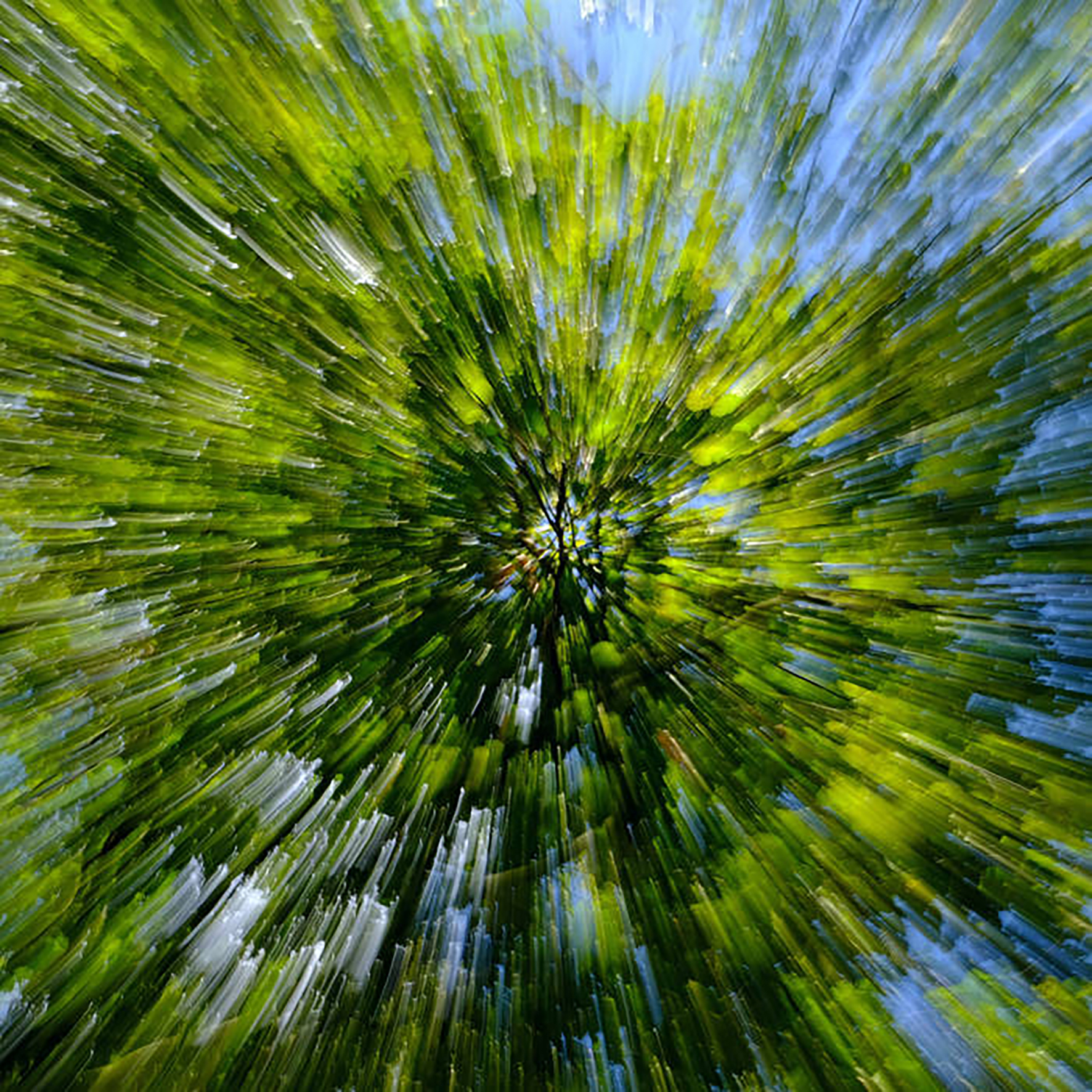
This latest solo album from Emptyset's James Ginzburg completely blindsided me, as it feels like his two of his longtime fascinations have finally converged into one gloriously crushing and intense tour de force. In characteristically cerebral fashion, Ginzburg conceived of crystallise, a frozen eye as an acoustic counterpoint to Emptyset's artificial intelligence-driven Blossoms, but what he ultimately arrived at feels considerably less conceptual than most Subtext albums. Or maybe the concept just feels completely eclipsed by the churning intensity of the music. In any case, this album feels like the most natural direction in the world now that it exists, as Ginzburg essentially just combined Emptyset's viscerally seismic approach to sound design with his deep interest in more traditional and earthy sounds (his previous solo album wove together strains of Gaelic folk music, Iranian traditional music, and Indian classical music). Yet another "obvious in hindsight" move was Ginzburg's leftfield decision to enlist devoted bass enthusiast/past collaborator Joker for the mastering role, ensuring that all of the songs pack some seriously house-shaking low-end heft. All of those seemingly disparate threads combine seamlessly to yield a work of almost elemental force that feels like the culminating achievement of Ginzburg's career. This has to be one of the heaviest and most unconventional drone albums of all time.
The album opens with something resembling the chiming of an old grandfather clock, which presumably indicates that it is now time to be enveloped in a churning and heaving sea of massive, buzzing strings. In that regard, "light evaporates" is a resounding triumph as a statement of intent, as it feels like miles of viscerally rattling, thick metal cables tuned to the resonant frequency of the earth are being shaken by a strong wind. That immense, buzzing behemoth is reasonably representative of the album, but Ginzburg is impressively inventive at achieving a similar effect in varied and divergent ways. For example, "on obsidian expanse" sounds like Glenn Branca's "Guitar Trio" if it had been written for an ensemble of cloned Ellen Fullmans (lots of buzzing, rattling strings, and droning unison notes). Unexpectedly, it transforms into an outro that feels like a psychedelic ancient palace ritual, but most other pieces undergo minimal transformation, as there is no reason to evolve further when a piece is an absolute monster right from the first notes. In fact, all eleven songs are legitimately awe-inspiring to some degree and some feel downright revelatory. The most adventurous one is probably "the eyes behind," which sounds like an orchestra trying to tune crystal instruments while broken glass rains down in slow motion and someone strangles a saxophone. However, the vaguely New Age-y "a gate left open disappeared" is an especially strange trip as well, as it sounds like an '80s synth guy trying to simultaneously evoke a giant celestial harp and compose a sequel to Music for Eighteen Musicians. That said, my favorite pieces mostly come near the end of the album and there are quite a few of them: "border, dispersing" (an ancient war procession crossing a mountain pass), "twilight in pierced velvet" (three killer noise guitar bands churning up a roiling cacophony), and "outside, infinite" (Branca reimagined as Eastern-inspired desert psychedelia). Only the latter dips its toes in any attempt at melody, but that is basically just gilding the lily when nearly every damn song is an immense, heaving and oft-rapturous celebration of visceral textures and harmonically rich seismic thrum.
Samples can be found here.
Read More
- Anthony D'Amico
- Albums and Singles

It has admittedly been quite a long time since the theatricality and ferocity of proper black metal held any allure for me, but the genre has certainly birthed quite a few fascinating mutant strains in the drone and psych realms over the years. The latest one to blindside me is this blackened drone leviathan from Norwegian trumpet visionary Espen Lund. Gleefully mangling the sound of his hapless trumpet is hardly new territory for Lund, but this album (his third) takes that approach to an ingenious extreme. As Lund himself put it, "The trouble with amplifying instruments that don't want to be amplified is the amount of feedback produced. On this album, the thought process was to incorporate the feedback and make it an integral part of the music." While I do believe that modest quote is factually correct, Aetonal instantly makes it feel like an almost cartoonishly massive understatement, as Lund and his ring of straining amplifiers unleash a crushing, snarling, and blown-out nightmare that is absolutely unrecognizable as a trumpet. If I heard this album completely blind, I would absolutely think I was hearing some killer Surface of the Earth, Campbell Kneale, or Southern Lord album that had somehow eluded me.
self-released
The opening "As Above, So Below" slowly rolls in like an moonlit fog enveloping an ancient Druidic ritual before dissolving into a brief, simple trumpet solo. And then all hell breaks loose, as the piece erupts into a roiling, ritualistic, and treble-ravaged channeling of recent Skullflower. It is a wonderfully face-melting assault (particularly for a lone trumpet), but it also surreptitiously evolves into something almost meditative (think "Sunn O))) as the house band at a Tibetan Buddhist temple"). Next, "For a Thousand Tongues to Sing" takes a somewhat similar path, approximating a doom metal band attempting to mimic a bagpipe ensemble, but then a war horn heralds a transformation into something best described as “sci-fi tribal meets a trippy '70s synth album being played through a noise band's gear." Aetonal does not truly catch fire until the grinding horror of the third piece, however, as "Speak Into His Good Eye" gleefully mashes together animal-like howls, maliciously weaponized feedback, machine-like rhythms, and an imagined duet between a calliope and rusty Ferris wheel in a nightmarish abandoned amusement park. "The Creator’s Voice" then steals the show, initially resembling a doom metal band soundtracking slow-motion footage of an avalanche, but ultimately passing through some mind-meltingly phantasmagoric stages such as "the world is burning and molten metal is dripping from the sky" and "a howling robot Tyrannosaurus just turned up and seems mad." It feels like the sort of scorched earth blow-out that nothing could follow, yet the closer is yet another stunner, ingeniously evolving from shrill, shimmering drones to "a terrifying feedback demon just materialized" to an unexpectedly beautiful and smoldering comedown. Generally, Aetonal is great because Lund and his trumpet unleash something resembling an absolutely essential masterpiece of late '90s New Zealand noise guitar, yet a few pieces hint at something more transcendent, like a faint rainbow appearing in the wake of an apocalyptic storm. That said, it also sounds like a copy of the Necronomicon mysteriously turned up at Lund's studio with a bookmarked page titled "Summon A Drone Album So Unholy That It Will Kill God." Aetonal is a towering achievement.
Samples can be found here.
Read More

